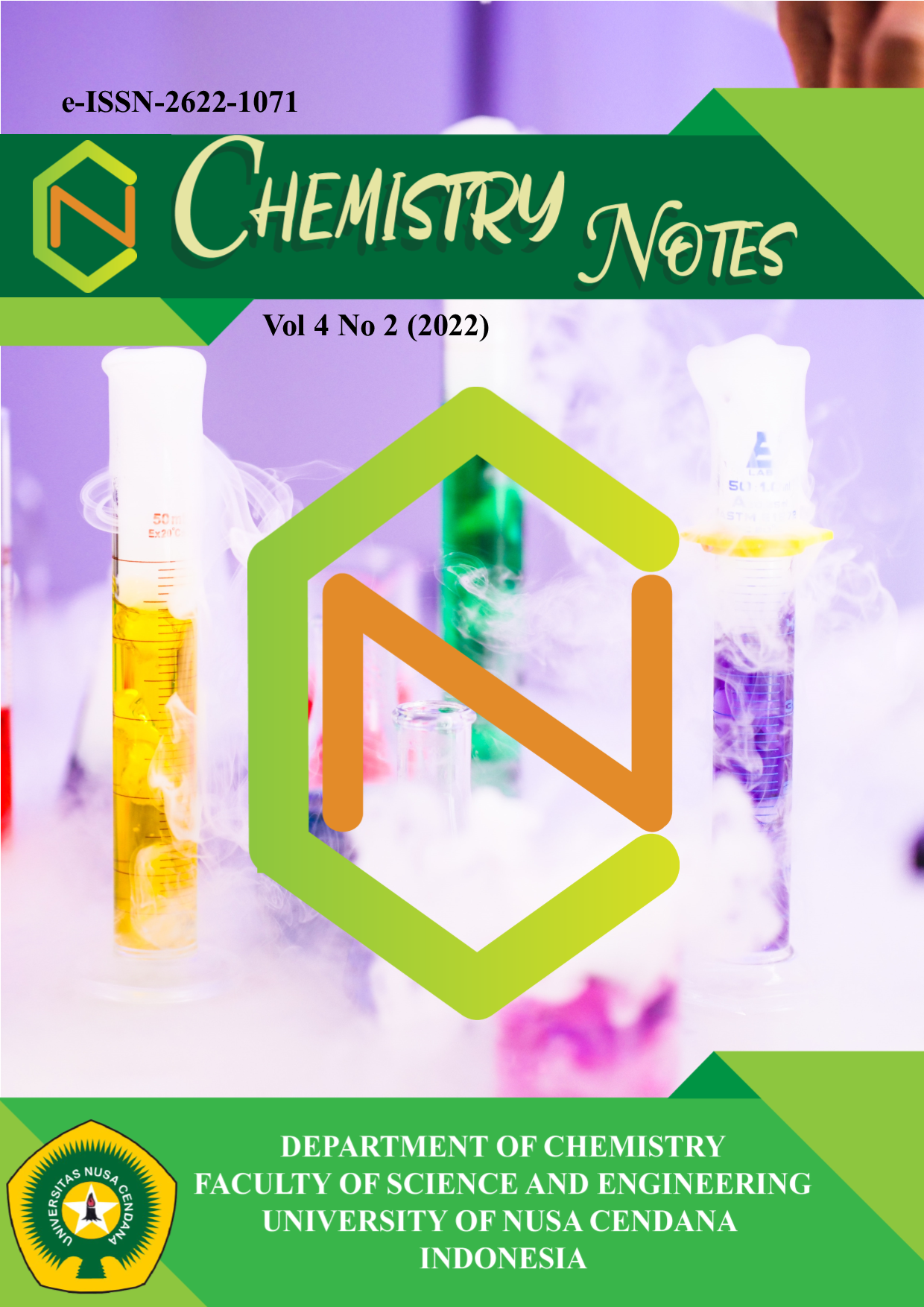Analisis Penurunan Kadar TSS, COD Dan BOD Pada Limbah Cair RSUD Mgr. Gabriel Manek, SVD Atambua Nusa Tenggara Timur Dengan Metode Elektrolisis
Abstract
A research on waste water treatment using electrolysis has been carried out. The purpose of this study was to determine the optimum condition of electric voltage or time in reducing the Total Suspended Solid (TSS), Chemical Oxygen Demand (COD) and Biochemical Oxygent Demand (BOD) of Mgr. Gabriel Manek, SVD hospitall’s waste effluent. The method used in this study was carbon-carbon electrolysis method. The results showed decreasing of TSS levels from 2880 mg/L to 40 mg/L with % removal of 98.61%, COD levels from 8,240 mg/L to 2,883 mg/L with % removal of 65.34% and BOD levels of 520 mg/L to 40 mg/L with a % removal of 92.30%.
Downloads
References
2. Said, N.I. 2006. Paket Teknologi Pengolahan Air Limbah Rumah Sakit yang Murah dan Efisien. Kelompok Teknologi Pengelolaan Air Bersih dan Limbah Cair, Pusat Pengkajian Dan Penerapan Teknologi Lingkungan, BPPT. JAI 2(1)
3. Peraturan Menteri Lingkungan Hidup Republik Indonesia No. 5 Tahun 2014 tentang Baku Mutu Air Limbah Industri
4. Andryanto dan Is Yuniarto. 2009. Pengaruh Waktu Ozonisasi Terhadap Penurunan Kadar BOD,COD, TSS Dan Fosfat Pada limbah Rumah Sakit. Yogyakarta: PTAPB
5. Sari, W. M. 2015. Pengolahan Air Limbah Rumah Sakit Muhammadiyah Palembang (RSMP) Dengan Sistem Biofilter Anaerob-Aerob. Fakultas Teknik: Palembang. Distilasi, 1(1): 7-18
6. Nugroho, S. 2013. Elektrodegradasi Indigosol Golden Yellow IRK dalam Limbah Batik dengan Elektroda Grafit. Skripsi tidak diterbitkan. Semarang : Jurusan Kimia, FMIPA UNNES
7. Avsar, Y. 2007. Comparison of Classical Chemical and Electrochemical Processes for Treating Rose Processing Wastewater. Journal of Hazardous Materials, 343: 341-342
8. Yulianto, A. 2009. Pengolahan Limbah Cair Industri Batik pada Skala Laboratorium dengan Menggunakan Metode Elektrokoagulasi. Jurusan Teknik Lingkungan. Universitas Islam Indonesia. Yogyakarta
9. Suyata, Irmanto & Rastuti, U. 2015. Penerapan Metode Elektrokimia untuk Penurunan COD dan TSS Limbah Cair Industri Tahu. Purwokerto : Jurusan Kimia, Fakultas MIPA Universitas Jendral Soedirman.
10. Hudha, M. I., Jimmy & Muyassaroh. 2014. Studi Penurunan COD dan TSS Limbah Cair Industri Tahu Menggunakan Proses Elektrokimia. Surabaya : Jurusan Kimia FMIPA Universitas Negeri Surabaya
11. Dianingtyas, Y. W. 2013. Pengolahan Limbah Cair Industri Percetakan Secara Elektrolisis dengan Elektroda Karbon
12. Kobaya, M., Orhan T.C., Mahmut. B. 2003. Treatment of Textile Wastewaters by Electrocoagulation Using Iron and Alumunium Electrodes. Journal of Hazardous Materials. Vol. 100. 163–178
13. Haris, A., Riyanti. A.D., & Gunawan. 2005. Pengendapan Logam Tembaga Dengan Metoda Elektrolisis Internal. Universitas Diponegoro. Vol 7 (2)
14. Tartakovsky B, Mehta P, Santoyo G, & Guiot SR. 2011. Maximizing Hydrogen Production in a Microbial Electrolysis Cell by Realtime Optimization of Applied Voltage. Int J Hydrogen Energy 36:10557e64
15. Timpua, T. K., & Pianaung. R. 2019. Uji Coba Desain Media Biofilter Anaerob Aerob Dalam Menurunkan Kadar Bod, Cod, Tss Dan Coliform Limbah Cair Rumah Sakit. Jurusan Kesehatan Lingkungan Poltekkes Kemenkes Manado. Vol 9. No. 1
16. SNI 6989.3:2019. Air dan Air Limbah-Bagian 3: Cara Uji Padatan Tersuspensi Total (Total Suspended Solid, TSS) Secara Gravimetri
In order to publish in Chemistry Notes, authors are required to agree to the copyright permission stating that the authors give the publisher the right to reproduce, display or distribute the accepted manuscript. In this agreement the authors also automatically declare that the submitted manuscript is exempted from plagiarism issue and conflict of interest among the authors.

 Sherlly M. F. Ledoh(1*)
Sherlly M. F. Ledoh(1*)





